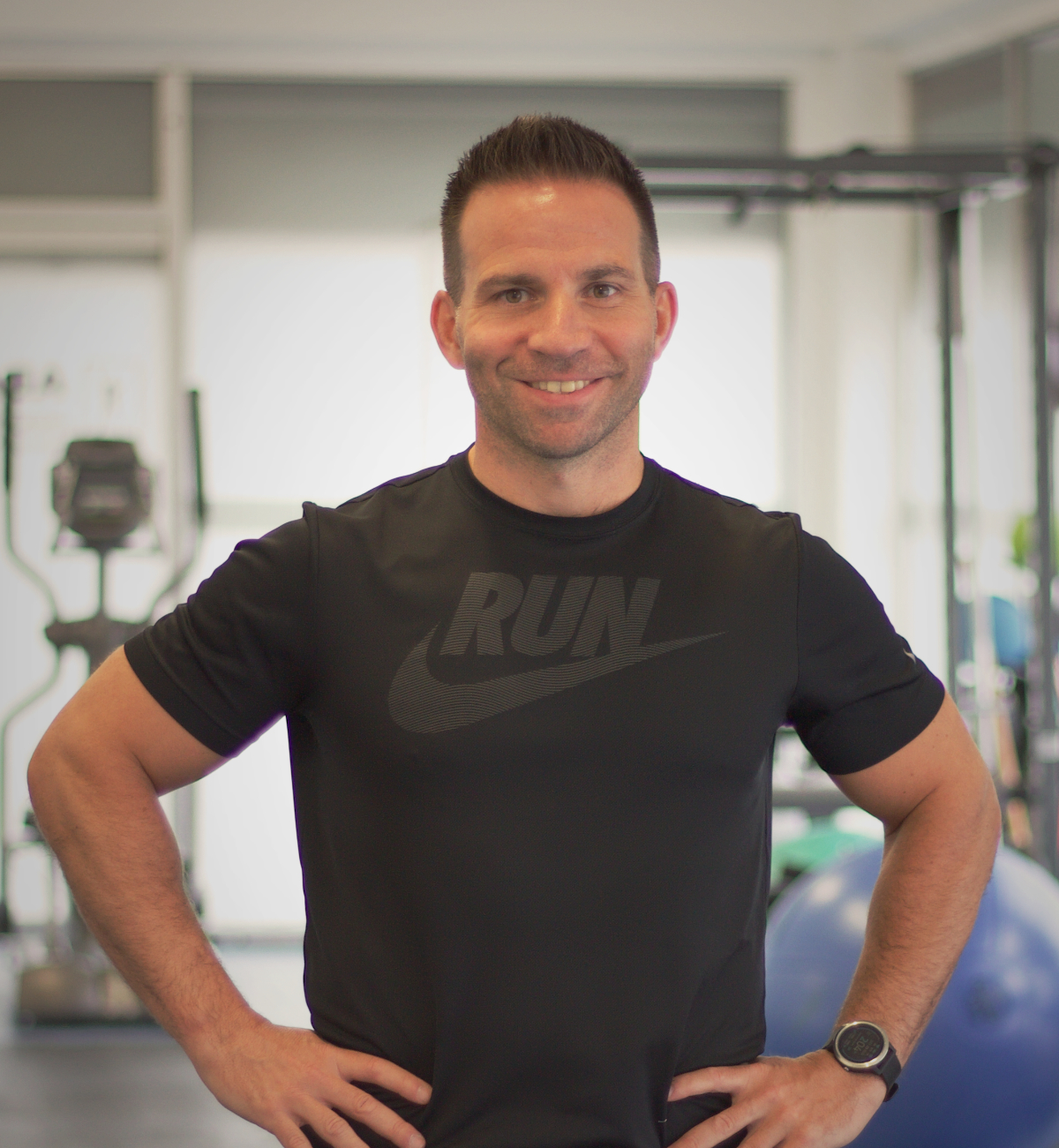Knee Pain Facts:
- Knee pain can occur because of tightness and weakness in the muscles
- Sitting for long periods (a scenario which I call ‘office back’) can lead to chronic knee pain
- Appropriate exercises can often remedy some causes of chronic knee pain
- Strengthening the Glutes (buttock) and Core (abdominal) muscles can decrease some cases of knee pain.
Dealing with Painful Knees
Painfully sore knees can literally stop you in your tracks. Everyday tasks can make you feel old before your time. Activities such as climbing stairs, running for the train and bending to pick something up can be extremely uncomfortable.
Sore knees can be caused by many reasons, namely an intrinsic or extrinsic injury. Intrinsic injuries occur within the body (a strain or a sprain for example). Extrinsic injuries occur outside of the body (getting hit across the legs with a hockey stick for example).
For the sake of this article I am going to begin by talking you through the intrinsic problems which can occur. I will also offer you some basic advice to help prevent these things from happening in the first place.
Please bear in mind that while I am a practising sports therapist I am not your doctor. This article should not be used to diagnose any aches or pains you may have and is for your information only.
Pain on the Kneecap
The patella is the medical name for your kneecap which is embedded inside connective tissue (the patella tendon). The patella then sits in a natural groove at the end of your femur (thigh bone) where the knee is formed. Inside that groove your kneecap slides backward and forward while the knee is bending and extending.
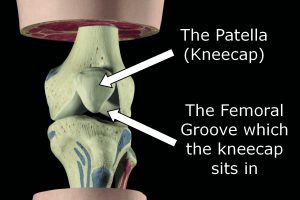 Poor Patella Tracking
Poor Patella Tracking
If, however, you have tight, weak quadricep (front of the leg) muscles, the kneecap can be pulled off centre. This can then force it to come away from its groove and to instead ’dig’ into the ridge of the groove underneath.
This usually happens when the outer thigh muscles are tight and dominant. In this scenario the inner quadricep muscle is often weak and fails to hold the knee is its proper place. Over time this can cause a repeated stress which causes pain. This is known as poor patella tracking and can become incredibly sore.
The Solution: Realigning the Tracking of Your Patella.
Postural correction involves more than simply strengthening the knee itself. Instead we must look more broadly to the other areas of the body which can influence the bio-mechanics of the knee.
This can involve the activation and strengthening of the core muscles (abdominals) the glutes (buttock muscles) and medial quads. It’s often advisable to release tension through foam rolling and stretching. The adductor muscles (inner thighs), the lateral quads (front of the thighs) and the I.T band (iliotibial band) should be targeted.
The ankles also play a huge part in this scenario so lower leg exercises are also relevant. Calf stretches, ankle mobility and stability exercises would be a useful addition to your programme. This is because the postural positioning of the ankle and foot can also influence how the patella tracks in the knee. Who would have thought a sore knee could be so complicated?!
Each case can be different of course so this is a simplified example not a prescriptive programme.
If all that sounds confusing, then please don’t fret. I will be posting a blog post with exercises specifically to help strengthen your knees in the near future to complement this post. If you haven’t already subscribed to my blog, please do so. The content is then emailed to you directly ensuring you don’t miss anything.
Patella Tendonitis
Tendonitis literally means ‘inflammation of the tendon’. Specifically, in this case, the patella tendon which the kneecap sits inside. The tendon’s job is to connect the big muscles on the front of the thighs (quadriceps) to your shin bone (the tibia).
Repeated Stress
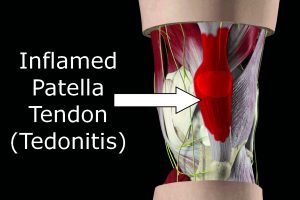 Tendonitis is a common ‘repeated stress’ overuse injury. This could be exercise related or postural if muscle imbalances are present. The stress then causes small ‘micro’ tears in the tissue which the body then tries to heal. The problem is tendons heal slowly as they have a poor blood supply. If the stress continues over time we can end up with a greater number of tears and a weaker tendon.
Tendonitis is a common ‘repeated stress’ overuse injury. This could be exercise related or postural if muscle imbalances are present. The stress then causes small ‘micro’ tears in the tissue which the body then tries to heal. The problem is tendons heal slowly as they have a poor blood supply. If the stress continues over time we can end up with a greater number of tears and a weaker tendon.
Imagine someone scratches your arm. It may be uncomfortable but you could cope. Now imagine they scratch the same spot 10,000 times and how unbearable that would become. Considering the average person should be walking 10,000 steps a day, that’s the trauma you knee could be under every single day from a repeated stress injury.
Tendonitis can happen if you don’t warm up or stretch properly. It can also occur if you repeatedly over-stress the knee-joint. This can be caused by excessively overloading the muscles with weights, impact exercise or aggressive stretching.
Healing Patella Tendonitis
Tendons take their time to repair. They don’t have a good blood supply so they heal incredibly slowly. The best thing you can do here is to apply ice to the inflamed area. This will offer you pain relief and help reduce the swelling.
In addition, you should also be doing exercises to build up the quadricep muscles to help support the knee better. In addition, including gentle stretching can help lengthen the tight muscles.
Arthritis
Repeated stress to the kneecap can cause degeneration over time. Excessively heavy loads and impact through the knee-joint can also exacerbate the problem long-term.
Through repeated stress, the shiny, hard hyaline cartilage which covers the kneecap can wear away exposing the bone underneath. This can be incredibly painful and can make walking and climbing stairs difficult.
Officially this is known as patellofemoral pain but your G.P may simply refer to it as arthritis which translates as ‘inflammation of the joint’.
There are other types of Arthritis which can affect the knees. Osteoarthritis (OA) is a ‘wear and tear’ based problem which affects the end of the two bones which form the knee. Over time the smooth, tough cartilage which protects the knee can degenerate and cause pain. Osteoarthritis is the most common form of arthritis in the knee and is most likely to occur after middle age.
Rheumatoid Arthritis is an inflammation based condition which can strike at any age. Finally, there is Post Traumatic Arthritis which can occur years after trauma to the knee (normally from another injury) has occurred.
Dealing with Arthritis
Degenerative arthritis doesn’t heal. Bone affected by arthritis does not regenerate in the same way which other areas of our body can. What you can do however is to improve your situation is to strengthen and stretch the muscles which surround the joint to begin protecting it better. In some cases, this can actually reduce arthritic pain considerably.
The best scenario here is to prevent damage in the first place. If you have arthritic knees or you think you may be likely to have weak knees later in life, your best bet is to keep them as healthy as possible. This is achieved by regular stretching and strengthening exercises.
Balance exercises are also particularly useful as they help stabilise the joint which improves its function.
Torn Meniscus Cartilage
The knee-joint comprises of the bottom of the thigh bone and the top of the shin bone. While impact travels through the bones through everyday tasks like walking and exercising you can imagine how the two bone ends which form the knee joint could clunk against each other.
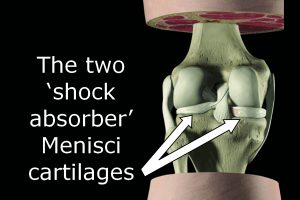 Shock Absorbers
Shock Absorbers
That’s why in the knee-joint we have special shock absorbers between the two bone ends to protect our knees called the Meniscus Cartilage or Menisci (plural).
Shaped liked two half-moons the Menisci sit snugly between the upper thigh bone (femur) and the lower shin bone (the tibia) inside the knee itself.
Causes of Menisci Tears
Sometimes if we have an accident involving twisting the knee heavily, falling, over stretching or huge impact going through the joint, the menisci can tear internally.
The tear creates a flap of tissue which moves around inside the knee. It can become impinged or trapped between the bones of the knee which can be very painful. Symptoms of a torn meniscus are sporadic pain, instability of the knee (it may occasionally ‘go’ from underneath you), and locking of the joint.
Managing a Torn Meniscus
If you are suffering from structural damage such as a torn meniscus cartilage, surgery may be an option. Cartilage doesn’t heal unlike skin or muscle tissue which can repair itself over time.
An arthroscopy (commonly known as keyhole surgery) can remove the damaged cartilage and tidy the inside of the knee up to help you move better again.
What Now?
Should you or someone you know be experiencing any of these problems, that person should speak to their G.P about being referred to a specialist. They will then offer them a diagnosis and the correct advice.
Prevention is Better Than Cure
The most important point here though is that you have a much better chance of preventing ALL of these problems if your body is strong, stable and flexible.
Stay Strong & Flexible
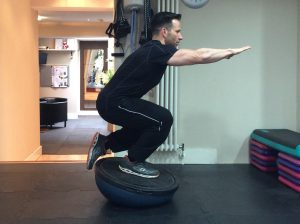 Strong muscles literally hold the knees in place, keeping them stable and therefore safe. In addition, you can challenge your body and they will stay stable.
Strong muscles literally hold the knees in place, keeping them stable and therefore safe. In addition, you can challenge your body and they will stay stable.
Flexible muscles mean a greater range of movement around the joints which means less stress on the soft tissues so problems like strains, sprains and tendonitis are less likely to happen. If you would like to start gentle stretching you can begin with my stretching programme post.
I wrote this post to simply highlight just a few of the more common problems that as a trainer / therapist I have come across over the years. Hopefully this will help offer some insight to you or for someone you know who has sore knees.
The Benefits of Exercise
I also wanted to write this post to stress the point that exercise shouldn’t just about losing weight, vanity and looking good. Sure it’s a massive bonus to look trim and feel confident. From a different viewpoint, exercise to keep your body strong and functional will also keep you feeling young, vibrant and full of energy. It will also keep you going with all the wonderful pastimes which life has to offer without restriction.
I’m not directing this point at older people either. I have known people in their twenties with chronic knee pain or back discomfort who aren’t enjoying a full quality of life due to their chronic repeated stress based injuries. If those people adopted a workout plan designed to rehabilitate their problem, their lifestyles would almost definitely improve. Food for thought for all of us.
If you have questions, have something to say or would like to share your sore knee stories, please do leave me a message in the comment section below. I would love to hear from you. As always, thank you so much for your time in visiting my blog and reading my post. I truly hope it has offered you some valuable insight.

